What Are The Most Deadliest Carnivorous Plants?: From insect-trapping mechanisms to digestive enzymes, these plants have some unique adaptations to capture and digest their prey. In this article, we’ll explore the different types of carnivorous plants and their unique features that make them so effective. We’ll also discuss why they are fascinating to humans and how to safely observe them without disturbing their natural behavior. So read on and discover just how intriguing these plants can be.
Types of Carnivorous Plants
There are several carnivorous plants that can be deadly, and it’s important to know the different types so you can stay safe! Carnivorous plants have adapted numerous strategies to capture prey, such as sticky surfaces or trapping mechanisms. The evolutionary origins of these adaptations are still being studied, but they have significant ecological implications due to their ability to thrive in nutrient-poor soils. These plants play an important role in preserving biodiversity and are even the subject of dedicated conservation efforts.
Carnivorous plants interact with other organisms in a variety of ways, from providing shelter for insects to serving as host for parasites. Some species also produce specialized chemical compounds which attract and trap prey. For example, pitcher plants use nectar secreted by glands at the rim of its pitchers to lure insects into its traps. This mechanism is highly effective at catching small animals such as ants and spiders, making them one of the most effective carnivorous plants at capturing their prey!
The ability of carnivorous plantshttps://predatorplant.com/how-do-carnivorous-plants-work-must-learn-this/ to survive in harsh environments has made them popular with gardeners looking for unusual specimens. However, many species face threats from habitat destruction or overharvesting by collectors who take them from the wild without permission. To protect these unique species from extinction, organizations like the International Carnivorous Plant Society strive to promote awareness about conservation efforts around the world.
Carnivorous plants offer us new insights into survival strategies that enable life even under extreme conditions – something we should all appreciate! With better understanding about their adaptations and interactions with other organisms comes a greater appreciation for these amazing living creatures and our responsibility towards protecting them.
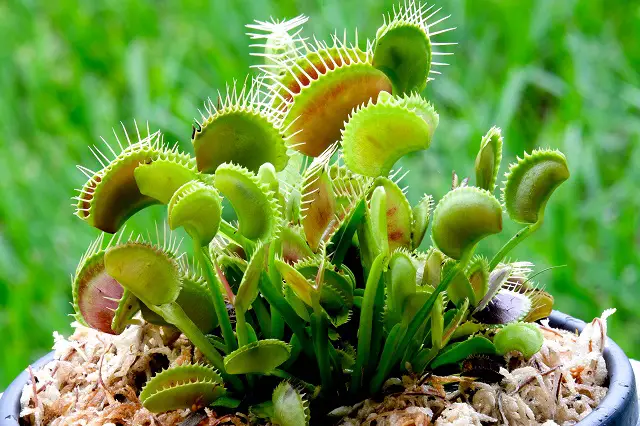
Insect-Trapping Tendrils
Reaching out like the arms of an eager predator, insect-trapping tendrils of carnivorous plants grasp and trap unsuspecting prey. These plants, which are some of the most uniquely adapted species on earth, have developed specialized adaptations that enable them to hunt and capture insects for sustenance. This is a testament to the marvels of evolution, as these plants have found a way to thrive in environments where other plant species would perish due to lack of nutrients.
Insect-trapping tendrils are a prime example of such adaptations. These tendrils, which are essentially modified leaves, are camouflaged traps designed to blend in seamlessly with their environment. This makes it incredibly difficult for prey to detect them until it is too late. They may appear harmless at first glance, but upon closer inspection, one can see the intricate design and functionality that make them perfect for capturing prey.
The process of capturing and digesting prey is a fascinating one. Once an insect lands on the tendril, it quickly finds itself stuck. The plant then begins to wrap its tendril around the prey, effectively trapping it. Once the insect is caught, the plant secretes various enzymes into the trap. These enzymes are designed to break down the insect’s body, facilitating digestion and allowing the plant to absorb the nutrients. This process provides the plant with the necessary nutrients for energy production and growth.
What’s even more remarkable is that these plants are able to survive and even thrive in nutrient-deficient soils. In these environments, where other plants struggle to find the nutrients they need, carnivorous plants have found a way to supplement their diet by capturing and digesting insects. This unique adaptation not only allows them to survive in such harsh conditions but also gives them a competitive edge over other plant species.
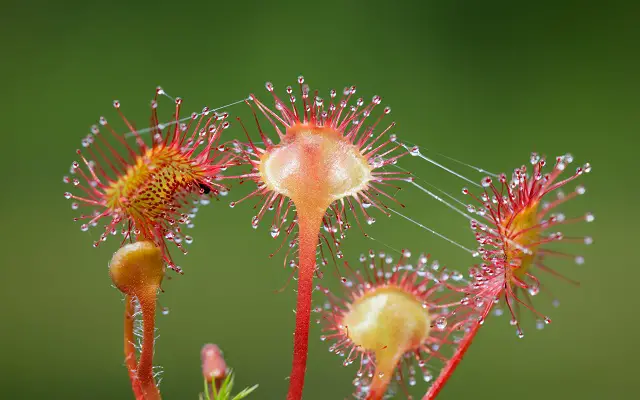
Insect-Trapping Mechanisms
Have you ever wondered how carnivorous plants capture their prey? Through evolutionary adaptations, these remarkable plants have developed specialized insect-trapping mechanisms. Interactions between the plant and pollinators have allowed them to develop strategies for capturing their prey more efficiently, which has had a profound impact on the ecosystems they inhabit.
One of the most common trapping mechanisms used by carnivorous plants is sticky traps. By producing mucilage from special glands on their leaves, these plants can trap any animal that brushes up against them. This method is primarily used by species such as sundews (Drosera spp.) and butterworts (Pinguicula spp.), and is considered one of the most efficient ways for them to capture prey.
Another type of insect-trapping mechanism involves snap traps, which are passive traps with hinged lobes that close when triggered by an unsuspecting insect. These traps are found in species such as the Venus flytrap (Dionaea muscipula). Another fascinating mechanism is the suction trap used by the waterwheel plant (Aldrovanda vesiculosa). This submerged trap uses rapid changes in pressure within the trap to suck in prey when triggered, allowing these species to catch even small aquatic organisms, providing them with an ample source of nutrition..
Carnivorous plants are often overlooked in conservation efforts due to their strange behavior, yet they are vital components of many ecosystems around the world. Understanding how they interact with other organisms through unique insect-trapping mechanisms provides insight into their importance within their environment – helping us better protect these incredible species!
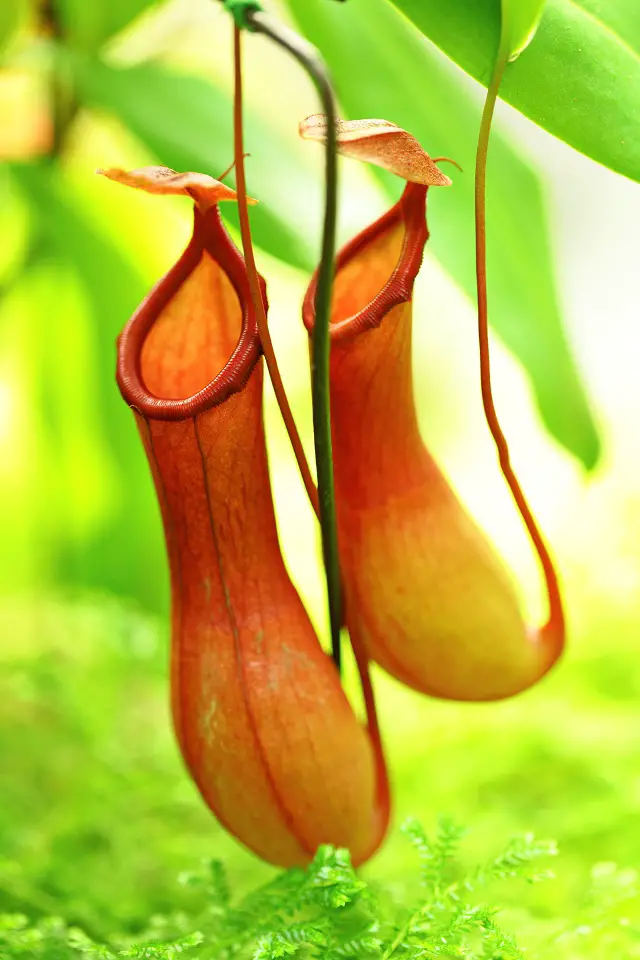
Unique Digestive Systems
Surrounded by danger, these remarkable creatures have evolved powerful digestive systems to help them survive. Carnivorous plants have adapted sophisticated ways of digesting their prey for nutrition and sustenance. Many feature unique traps that draw in unsuspecting insects, allowing the plant to capture and consume its food source with ease. The digestive process begins once the insect is inside the trap, as secretions from the plant begin breaking down the prey into useful nutrients.
The digestive system of some carnivorous plants is highly specialized in order to effectively capture and process insect prey. For example, some species create a slippery surface on their leaves which makes it difficult for insects to escape after entering the trap; other species use a suction mechanism triggered by hairs on their leaves that instantly draws an insect into its clutches when touched. Each carnivorous adaptation offers evolutionary advantages in terms of plant survival and further enhances its ability to catch and digest prey efficiently.
Once an insect has been trapped, these plants secrete enzymes into their traps that break down proteins from the victim’s body in order to extract essential amino acids vital for growth and development. It’s an efficient way of getting essential nutrients without having to rely on external sources like soil or sunlight – something most non-carnivorous plants must do for nourishment and survival.
Carnivorous plants are able to live off of small amounts of energy found within insects as opposed to using photosynthesis like most other vegetation; this allows them thrive in nutrient-poor environments where other forms of life cannot survive under normal conditions. As such, they offer insight into how organisms can adapt in harsh climates with limited resources available for sustenance – even if it means eating another living creature!
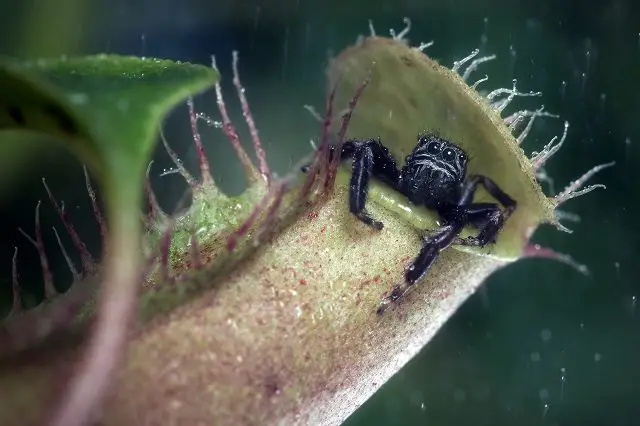
Attractive Nectar
Some carnivorous plants have evolved to produce highly attractive nectars as a means to lure in unsuspecting prey. This is a fascinating adaptation that showcases the ingenuity of nature in ensuring survival. For instance, the Venus Flytrap, a well-known carnivorous plant, produces a sweet-smelling nectar that is irresistible to many insects. This nectar serves as a potent lure, drawing in any insect that is unfortunate enough to come within its reach. Once the insect lands on the plant, attracted by the tantalizing scent of the nectar, the trap is sprung and the insect is caught within the plant’s jaws.
This type of attraction mechanism has evolved in some plants as a way of ensuring a steady supply of nutrients. In environments where nutrients are scarce, carnivorous plants have turned to an alternative food source – insects. By producing a nectar that insects find irresistible, these plants can ensure a constant supply of food.
In addition to luring prey, the carnivorous plants’ nectar also plays a crucial role in attracting pollinators. Pollinators, drawn to the plant by the scent of the nectar, often unknowingly transport pollen from one plant to another. This aids in the plant’s reproduction, ensuring the continuation of the species. This is a delicate balance, as the plant must attract pollinators for reproduction without capturing and digesting them.
Furthermore, these nectars act as a form of chemical attraction, allowing the plant to draw in insects that would otherwise pass it by. The nectar’s scent can travel on the wind, attracting insects from a wide area. This increases the plant’s chances of capturing prey, as it is not solely reliant on the insects that happen to pass close by.
Specialized Foliage
You could be in for a fascinating surprise if you examine the foliage of some carnivorous plants, as they may have unique properties that aid in their survival. Some of these plants have evolved to produce specialized structures in their leaves and petals to trap and digest their prey. These adaptations are often highly specialized and vary greatly among species, making them particularly interesting when encountered in the wild
| Plant | Specialized Foliage | Effective Traps |
|---|---|---|
| Drosera Rotundifolia | Tiny hairs with a sticky fluid on them which contains toxins that can irritate skin and eyes | Tiny hairs with a sticky fluid on them which can trap insects – Sticky slime-covered traps which entangle insects and slowly digest them over time. |
| Sarracenia Purpurea | Barbed hairs on its leaves that contain irritating chemicals which irritate skin, eyes, and mucus membranes | Sarracenia Purpurea – Barbed hairs on its leaves that can trap insects – Pitcher-like traps filled with digestive enzymes that break down the trapped insects. |
| Dionaea Muscipula | Small sharp spines along its edges which inject toxins into victims upon contact | Hinged jaws lined with sharp teeth-like structures that quickly close shut around an insect trapping it inside forever |
Carnivorous plants use their venomous foliage to attract prey as well as ward off predators. They lure unsuspecting victims with colorful flowers, sweet scents, and other enticing features while simultaneously protecting themselves from danger. Once these insects make contact with the plant’s toxic petals or razor-sharp spines, they become immobilized by the deadly toxins injected into their bodies. The plant then seals its lethal trap shut so tightly that there is no escape for the helpless insect. It is this combination of dangerous seduction and lethal traps that makes these plants amongst the most deadliest carnivorous varieties known to man.
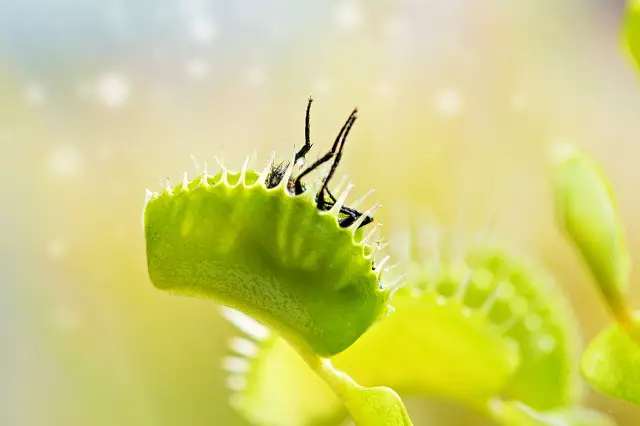
Luring Fragrances
Be enticed by the fragrant aromas of carnivorous plants; some have been known to attract prey from up to three meters away with their tantalizing scents. These alluring scents come in a variety of forms, ranging from sweet and fruity to spicy and pungent. The combination of these fragrant lures can be so powerful that it can overwhelm an insect’s senses, causing them to become disoriented or even immobilized. In addition, the scent-based traps employed by carnivorous plants are often further enhanced by visible cues such as bright colors or patterns that help draw attention to the plant.
The attractive fragrances used by carnivorous plants vary greatly depending on the species. For example, pitcher plants produce a blend of molecules that mimic those found in rotting fruit while sundews emit complex mixtures containing compounds similar to those in honeydew secreted by aphids. Many other species have adapted aromatic enticements designed specifically for their local environment and preferred prey.
It is thought that many carnivorous plant species evolved their scent-based traps as a way of supplementing their nutrient intake in areas where they otherwise may not receive enough nutrition from soil alone. By using these olfactory lures, they are able to capture more unsuspecting insects than if they relied solely on passive trapping mechanisms like sticky surfaces or slippery slopes. This increases their survival rate which helps them thrive even under harsh conditions where food resources are scarce.
A fascinating aspect of this adaptation is that many carnivorous plants also use odors as a form of defense against potential predators such as herbivores or other competing plant species. To ward off would-be attackers, some species release strong volatile compounds that act as deterrents while others emit chemicals which interfere with the physiology of nearby organisms resulting in nausea and vomiting sensations when inhaled or ingested. No matter how you look at it, these remarkable creatures demonstrate just how ingenious nature can be!
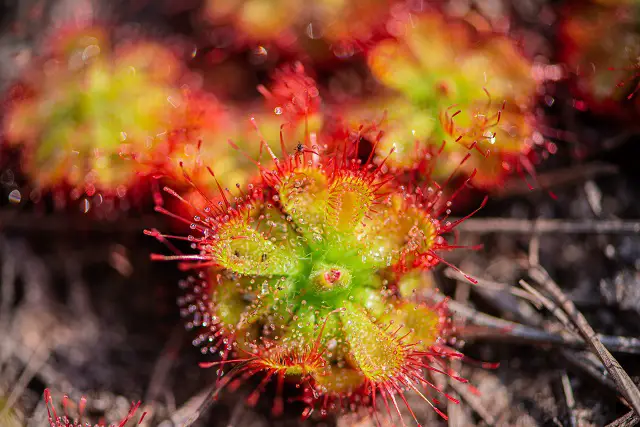
Frequently Asked Questions
What precautions should I take when growing carnivorous plants?
When growing carnivorous plants, it’s important to take safety precautions to ensure their health. It is essential to find out the specific watering techniques, fertilizing needs, soil types, and pest control for each species of plant. Make sure that you use a soil type that contains zero fertilizer as this can be fatal for some species. Additionally, create an environment with the right climate requirements so the plant can thrive in its natural habitat. Lastly, regular maintenance such as cleaning and trimming will help keep your carnivorous plants healthy and safe.
Are carnivorous plants dangerous to humans?
Carnivorous plants can be dangerous to humans, depending on the species and its toxicity levels. It is important to understand the pest control capabilities of carnivorous plants as well as their environmental impact before making a decision about cultivating them. Additionally, ethical considerations must be taken into account when deciding whether or not to grow these plants, such as whether it is right for anyone to keep an animal-eating plant in captivity. Finally, cultural implications should be considered in order to ensure that any cultivation of carnivorous plants does not result in a negative impact on local communities.
Are carnivorous plants legal to own?
Owning carnivorous plants can be a rewarding and unique experience. However, you must check the local regulations in your area as exotic species of carnivorous plants may be illegal to own. You also need to ensure that you have the right soil nutrition and water conditions for the plant, as well as maintain feeding regulations so that it is not overfed or malnourished. Lastly, many people use carnivorous plants as an effective pest control measure; make sure this is allowed in your area before deciding to get one.
Are there any carnivorous plants that don’t require a lot of maintenance?
Traveling back to a time before the age of modern conveniences, you can imagine a world where nature reigns supreme. But even in this wild kingdom there are some plants that stand out from the rest. Carnivorous plants don’t require a lot of maintenance, and they come in all shapes and sizes. When considering carnivorous plants for your home, you should consider their feeding requirements, soil composition, indoor cultivation needs, fertilizer use, and pest control. By taking these factors into consideration you can ensure the health and longevity of your carnivorous plant without having to worry about it becoming too demanding or dangerous.
Are there any carnivorous plants that don’t require a lot of light?
Yes, there are carnivorous plants that don’t require a lot of light. Many species of carnivorous plants are adapted to live in shady areas and low light conditions, such as Venus flytraps and pitcher plants. To ensure their success, these plants must be given the appropriate feeding techniques, water requirements, soil types, humidity levels and pest control. Additionally, they must be monitored for signs of stress due to too little or too much light. With careful monitoring and attention to detail, you can have your own successful low-light carnivorous plant!
Conclusion
You’ve come to the end of your journey through the world’s most dangerous carnivorous plants. From venomous tendrils, insect-trapping mechanisms, unique digestive systems, toxic nectar, and venomous foliage to luring fragrances – these plants are as deadly as they are fascinating. As you now know, it is important to be aware of the threats these plants pose and take precautions when coming into contact with them. With knowledge comes power: by educating yourself about these dangers and taking steps to protect yourself from them, you can enjoy nature safely and securely.


